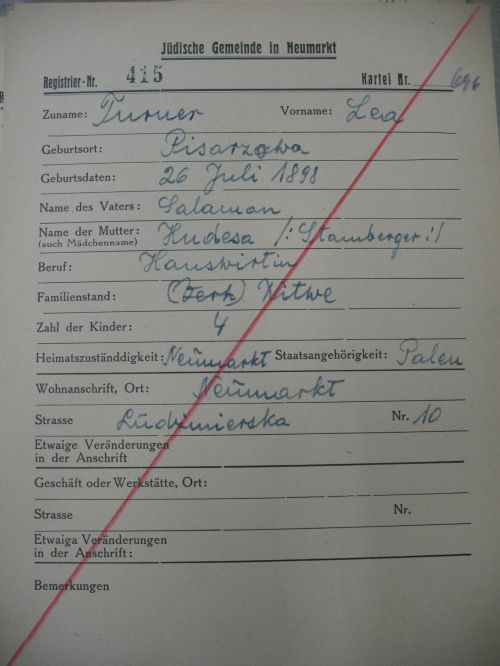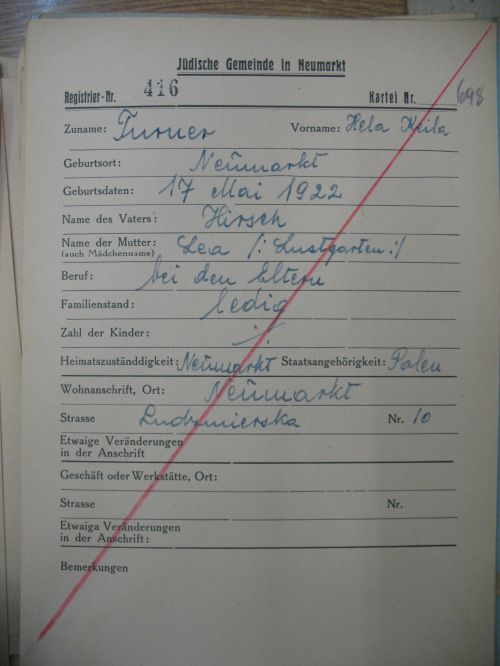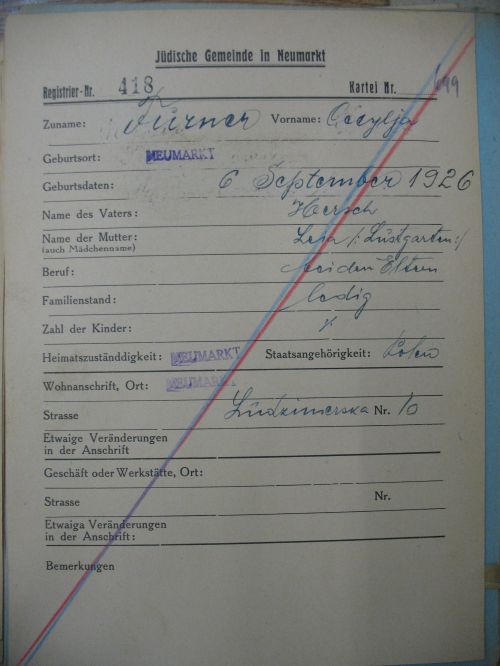Nowy Targ
Nowy Targ is located approximately 50 miles south of Krakow. In 1921, there were 1,342 Jews living in the town, which was some 16 per cent of the total population. In 1939, on the eve of the Second World War, there were approximately 2,500 Jews living in Nowy Targ.The German Wehrmacht occupied Nowy Targ on September 1, 1939, the first day of the invasion, due to the town's proximity to the border with Czechoslovakia. A few Jews fled to Eastern Galicia ahead of the German advance. The Soviet authorities subsequently deported most of these Jews to Siberia after they occupied eastern Poland in mid-September. As soon as the Germans occupied Nowy Targ, they arrested 12 Jewish community leaders on the pretext they had fired on German troops, then sent them to a concentration camp in Germany.
Accompanying the German army were mobile forces of the Sicherheitspolizei Einsatzkommando 3/1 commanded by Dr. Alfred Hasselberg, who was born on August 30, 1908, in Essen, and who later served with the Gestapo in Lublin. His forces advanced through Zakopane to Nowy Targ. According to one source Hasselberg's forces murdered 45 Jews in the Nowy Targ area before moving on to Nowy Sacs and Jaroslaw.
Among the first decrees issued by the German authorities was for all Jewish businesses to be taken over by a custodian. The larger concerns were handed over to local ethnic Germans, and the smaller concerns were liquidated. All Jews over the age of 10, had to wear the Star of David on their clothing. Jews were not permitted on the town square or the main streets, and they could not buy food in Polish stores.
From November 12, 1939, Nowy Targ came under the supervision of SS-Hauptsturmfuhrer Robert Philip Weissmann, the head of the Security Police in Kreis Neumarkt, whose headquarters was located in Zakopane. The Germans established a Jewish Council (Judenrat) consisting of 12 members chaired by Meir Ginsberg. The Judenrat's duties included preparing lists of Jews for forced labour and collecting 'contributions' for the Germans. No Jewish police force was created. The Jews were conscripted to perform various forced labour assignments in the town and to work for the Germans. Jews from Nowy Targ also worked in a stone quarry in Zakopane. The workers received meagre food rations and had to work long hours . They were able to receive parcels from relatives provided an 'Aryan' delivered the parcels to the Zakopane Judenrat for distribution.
The Nowy Targ Jewish Residential Area, which was an 'open ghetto' was created in May 1941. It was located between Krasinskiego, Waksmund, Nadwodna, Jan Kazimierz and Dorota Streets. Its area was approximately was approximately 1,000 square meters. Initially, approximately 2,000 Jews from Nowy Targ and the surrounding area was concentrated there. According to a report by the Kreishauptmann in Nowy Targ written at the beginning of June 1941, 'the area around Zakopane had been cleared of Jews up to the gates of Nowy Targ. The Jews in Neumarkt were currently being concentrated in a ghetto, which later on was also able to absorb the Jews from the other locations in the Kreis.'
The area of the open ghetto in Nowy Targ was very small and dilapidated. The Jews were persecuted and harassed. For example, the Weissmann family was killed because they bore the same name, as the head of the Security Police in Zakopane, Robert Philip Weissmann. From October 15, 1941, leaving the Jewish residential area without special permission was punishable by death.
Random executions of Jews intensified. The Germans executed several Jews from the Nowy Targ ghetto in the Bolfark Forest near the town. On June 8, 1942, the Germans took several Jews from a feather-plucking plant, shooting and burying them at the Jewish cemetery. Also Jews charged with trading in foreign currency were taken to the Sicherheitspolizei und SD Schule in Rabka, where they were tortured and murdered.
At the end of July 1942, or at the beginning of August 1942, SS-Oberfuhrer Julian Scherner, the commander of the Security Police in Krakau, ordered that the Jews Szczawnica, Kraisiuski, and other villages should be concentrated in Nowy Targ briefly, prior to their deportation. Those who were too old or sick to be moved were to be shot on the spot. During August 1942, these orders were implemented, resulting in an additional influx of several hundred Jews into the Nowy Targ ghetto. In Szczawnica, for example, a Security Police detachment commanded by Richard Schmisch shot 39 Jews, sending the remainder to Nowy Targ.
On August 29, 1942, the Nowy Targ Judenrat, on instructions from the Germans, announced that all Jews were required to assemble in the Pilsudski sports stadium the following morning. The Jews were told they would be sent to work in the Reichskommissariat Ukraine, and that they should bring a small amount of luggage. Approximately 3,500 Jews assembled at the stadium, where German and Polish police surrounded them. Then SS-Hauptsturmfuhrer Robert Philip Weissman carried out a selection. Old and infirm Jews were hurriedly sent to one side, together with members of the Judenrat.
Jews with special skills or craftsmen were also selected into another group on the basis of a list from the Arbeitsamt (work office) and separated from their families. The Jews were then made to surrender their valuables, and those who were selected for work were loaded onto trucks and taken to a collection point under guard. The mass of the Jews were then escorted to the railway station and loaded onto cattle cars to be sent to the Belzec death camp. Jews from the neighbouring town of Jordanow were added to the deportation train, following a similar Aktion there, on the same day.
In Nowy Targ, the elderly, and infirm together with the Judenrat members were taken to the Jewish cemetery, where they were shot and killed. Polish members of the conscripted Baudienst - Construction Service filled in the mass grave. David Grassgreen managed to escape the shooting, as he knew the hidden trails in the area. Following the ghetto liquidation, the Germans and Polish police forces combed the Jewish houses, looking for Jews in hiding. Over the following months a number of Jews were captured and shot in the Nowy Targ area.
A Labour camp was established in Nowy Targ on August 30, 1942. It was located in a barracks behind the train station. The labour force consisted of approximately 35 Jews who had been spared deportation from Nowy Targ ghetto. The prisoners performed the following types of work: carpentry, plumbing, shoe-making, and sewing. The prisoners also had to sort the clothing that belonged to the murdered Jews. Approximately 10 of the prisoners died in a typhus epidemic. The Germans executed some inmates outside the labour camp. When the camp was liquidated on May 25, 1944, the remaining prisoners were taken to the Plaszow forced labour camp in Krakau.
After the Second World War had ended, a few Jewish survivors returned to Nowy Targ and established a local Jewish committee in the town. According to the Yizkor book, Poles belonging to the extremist right-wing organisation NSZ, began attacking and harassing the Jews. Chairman Klinger and six other Jews were given 24 hours notice to leave town; they were shot before the required time elapsed. David Grassgreen, who escaped from the cemetery during the August 1942 Aktion, was also murdered following his requests to the Polish Ministry of Interior, for the return of the synagogue, which had been converted into a film theatre. This wave of anti-Semitic violence convinced the remaining Jews not to remain in Poland, most then emigrated to Israel and the United States of America.
One family's tale from Nowy Targ - Eleonora Turner
TURNER, Eleonora
Eleonora (Lea) Turner was born on July 26, 1898, to parents Shlomo and Yehudit, in Pisarzowa, Poland. She married Tzvi Hersch and moved with him to Nowy Targ in 1918. They lived at 10 Ludzmierska Street where Hersch ran a butchery. They had four children. After her husband's death in 1927, Eleonora never remarried. Her sons Heniek and Mojzesz who survived the Holocaust, remembered her as an educated, lively, and friendly woman, who gave charity and help, to all who needed it.
She managed to balance running the butchery with motherhood. She was deported along with her two daughters Hela, Keila, who was born on May 17, 1922, and Cela Cecylia who was born on September 6, 1926, to the Belzec death camp on August 30, 1942, where they were all murdered.



Jewish Council Registration Cards for the Turner Family who perished at Belzec (Courtesy of Tali Nates)
Sources:
The Encyclopaedia of Camps and Ghettos 1933-1945, USHMM, Indianna University Press Bloomington and Indianapolis 2012.
French L MacLean, The Field Men, Schiffer Military History, Atglen PA, 1999
Documents supplied by Tali Nates (Johannesburg Holocaust Centre)
© Holocaust Historical Society February 17, 2020

